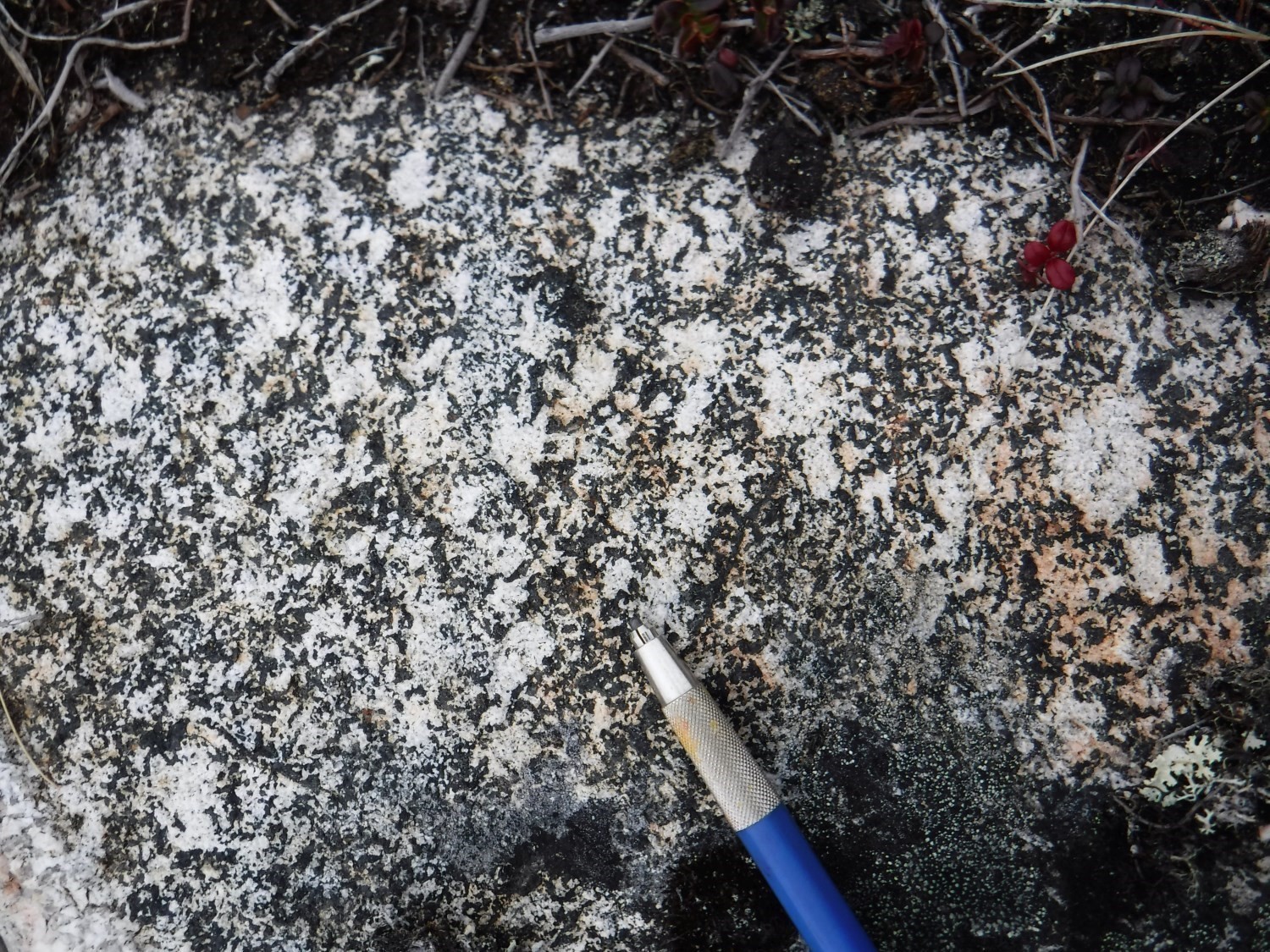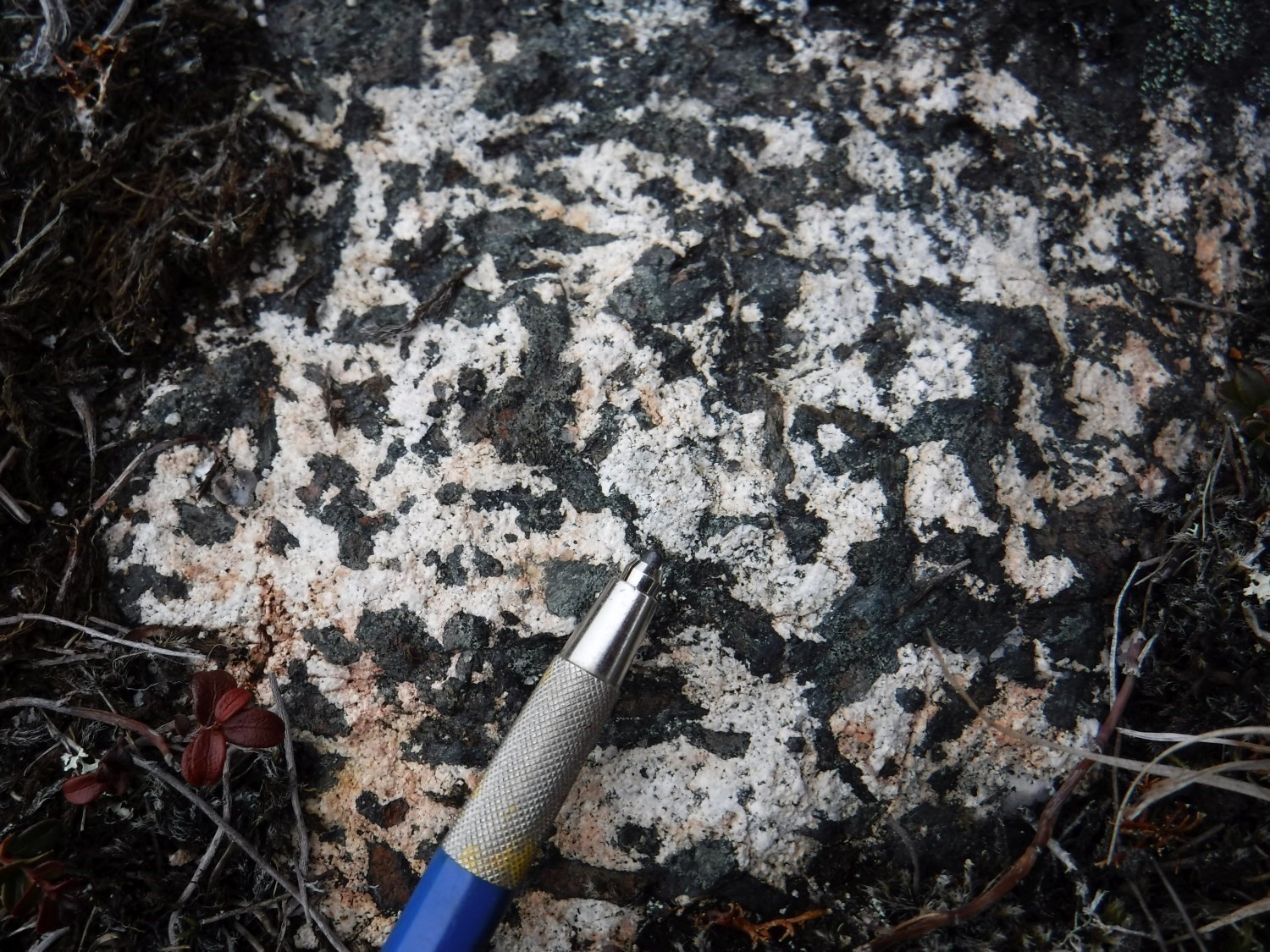
| Author: | Charette and Beaudette, 2018 |
| Age: | Paleoproterozoic |
| Stratotype: | Frichet River, NTS sheet 35F13 (type locality) |
| Type area: | NW part of the Ungava Peninsula |
| Geological province: | Churchill Province |
| Geological subdivision: | Ungava Orogen / Narsajuaq Lithotectonic Domain |
| Lithology: | Intermediate intrusive rock |
| Category: | Lithodemic |
| Rank: | Suite |
| Status: | Formal |
| Use: | Active |
None
Background
The Frichet Suite was introduced by Charette and Beaudette (2018) to describe coarse-grained, locally porphyraceous, and recrystallized intermediate intrusions of the Narsajuaq Domain. It was extended in the SW part of the Sirmiq Lake area (Vanier and Lafrance, 2020). The name of this suite comes from the river of the same name near the largest intrusion of jotunite and hypersthene diorite.
Description
The majority of the Frichet Suite consists of orthopyroxene-clinopyroxene jotunite and diorite. These lithologies, usually coarse-grained, are white and black in altered surface and have a characteristic granoblastic speckled appearance. This appearance is produced by centimetric clusters of greenish and brownish ferromagnesian minerals and, in places, by a porphyraceous texture with plagioclase or K-feldspar phenocrystals 0.5-2 cm, recrystallized or not. The jotunite’s texture varies from foliated to massive approaching the core of larger intrusions. When the rock is deformed, ferromagnesian mineral clusters and phenocrystals form lenses stretched in the foliation plane. Ferromagnesian minerals make up 20 to 45% of the rock and, locally have a heterogeneous distribution. Orthopyroxene is commonly fractured and partially replaced by biotite or serpentine. Replacement is locally complete; only clusters of skeletal and radial biotite remain, intergrown with quartz. These samples then lose the characteristic greenish or brown colour of orthopyroxene rocks. Pyroxene is found in the core of recrystallized hornblende crystal clusters. Hornblende is the main ferromagnesian mineral and is locally replaced by biotite. Accessory minerals include magnetite, garnet, pyrite, apatite, chlorite, carbonate and zircon. In the matrix, plagioclase crystals are partially recrystallized and are moderately to strongly saussuritized.
Other intrusive lithologies associated with jotunite are observed on some outcrops. The first is a coarse-grained leucogabbronorite, containing less ferromagnesian minerals (5-25%) than jotunite. However, like the latter, it contains centimetric clusters of ferromagnesian minerals giving a speckled appearance to the rock. The second, of gabbroic composition, contains up to 60% ferromagnesian minerals. It is is homogeneous, medium to coarse grained and is distinguished from other lithologies by the absence of porphyraceous and speckled textures. Jotunite also contains ultramafic layers (websterite, olivine websterite locally) and garnet gabbronorite enclaves.
Thickness and Distribution
The Frichet Suite appears as a large sigmoid mass >35 km by 3 km (NTS sheet 35F13), as well as small plutons stretched along the regional foliation (~5 km by 1 km). These plutons concentrate within or near the Sugluk Shear Zone. In contact with the latter, jotunite forms an elongated mass oriented E-W and in tectonic contact with granulitic gneiss of the Estre Complex.
Dating
None.
Stratigraphic Relationship(s)
The Frichet Suite is generally spatially associated with porphyraceous or porphyroclastic felsic-intermediate units of the Suluraaq Suite. Intrusive rocks of the Frichet and Suluraaq suites both forms competent masses in the vicinity of the Sugluk Shear Zone. Both of these could be cogenetic. The Frichet Suite intrusions cut gabbronorite, gabbro and diorite of the Pingasualuit Complex. These lithologies also occur as enclaves in mafic intrusive rocks.
Paleontology
Does not apply.
References
Publications Available Trough SIGÉOM Examine
CHARETTE, B., BEAUDETTE, M. 2018. Geology of the Cape Wolstenholme Area, Ungava Orogen, Churchill Province, Southeast Ivujivik, Quebec, Canada. MERN. BG 2018-03, 1 plan.
VANIER, M.-A., LAFRANCE, I. 2020. Geology of the Sirmiq Lake Area, Ungava Orogen, Nunavik, Quebec, Canada. MERN. BG 2020-02, 1 plan.
Suggested Citation
Ministère de l’Énergie et des Ressources naturelles (MERN). Frichet Suite. Quebec Stratigraphic Lexicon. https://gq.mines.gouv.qc.ca/lexique-stratigraphique/province-de-churchill/suite-de-frichet_en [accessed on Day Month Year].
Contributors
|
First Publication |
Benoit Charette, P. Geo., M.Sc. benoit.charette@mern.gouv.qc.ca; Mélanie Beaudette, GIT, B.Sc. melanie.beaudette@mern.gouv.qc.ca (redaction) Mehdi A. Guemache, P. Geo., Ph.D. (coordination); Mélina Langevin, GIT, B.Sc. (critical review); Simon Auclair, P. Geo., M.Sc. (editing); Marie-Ève Lagacé (HTML editing); Céline Dupuis, P. Geo., Ph. D. (English version). |
|
Revision(s) |
Isabelle Lafrance, P. Geo., M.Sc. isabelle.lafrance@mern.gouv.qc.ca; Marc-Antoine Vanier, Jr. Eng., M.Sc. marc-antoine.vanier@mern.gouv.qc.ca (redaction) Mehdi A. Guemache, P. Geo., Ph.D. (coordination); Benoit Charette, P. Geo., M.Sc. (critical review); Simon Auclair, P. Geo., M.Sc. (editing); Nathalie Bouchard (HTML editing); Céline Dupuis, P. Geo., Ph.D. (English version). |




